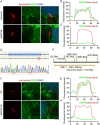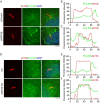INPP5E Regulates the Distribution of Phospholipids on Cilia in RPE1 Cells
- PMID: 38514901
- PMCID: PMC11033345
- DOI: 10.1002/jcla.25031
INPP5E Regulates the Distribution of Phospholipids on Cilia in RPE1 Cells
Abstract
Background: Primary cilia are static microtubule-based structures protruding from the cell surface and present on most vertebrate cells. The appropriate localization of phospholipids is essential for cilia formation and stability. INPP5E is a cilia-localized inositol 5-phosphatase; its deletion alters the phosphoinositide composition in the ciliary membrane, disrupting ciliary function.
Methods: The EGFP-2xP4MSidM, PHPLCδ1-EGFP, and SMO-tRFP plasmids were constructed by the Gateway system to establish a stable RPE1 cell line. The INPP5E KO RPE1 cell line was constructed with the CRISPR/Cas9 system. The localization of INPP5E and the distribution of PI(4,5)P2 and PI4P were examined by immunofluorescence microscopy. The fluorescence intensity co-localized with cilia was quantified by ImageJ.
Results: In RPE1 cells, PI4P is localized at the ciliary membrane, whereas PI(4,5)P2 is localized at the base of cilia. Knocking down or knocking out INPP5E alters this distribution, resulting in the distribution of PI(4,5)P2 along the ciliary membrane and the disappearance of PI4P from the cilia. Meanwhile, PI(4,5)P2 is located in the ciliary membrane labeled by SMO-tRFP.
Conclusions: INPP5E regulates the distribution of phosphoinositide on cilia. PI(4,5)P2 localizes at the ciliary membrane labeled with SMO-tRFP, indicating that ciliary pocket membrane contains PI(4,5)P2, and phosphoinositide composition in early membrane structures may differ from that in mature ciliary membrane.
Keywords: INPP5E; PI(4,5)P2; PI4P; ciliary base; primary cilia.
© 2024 The Authors. Journal of Clinical Laboratory Analysis published by Wiley Periodicals LLC.
Conflict of interest statement
The authors declare no conflicts of interest.
Figures





Similar articles
-
Phosphoinositides Regulate Ciliary Protein Trafficking to Modulate Hedgehog Signaling.Dev Cell. 2015 Aug 24;34(4):400-409. doi: 10.1016/j.devcel.2015.08.001. Dev Cell. 2015. PMID: 26305592 Free PMC article.
-
Modulation of Ciliary Phosphoinositide Content Regulates Trafficking and Sonic Hedgehog Signaling Output.Dev Cell. 2015 Aug 10;34(3):338-50. doi: 10.1016/j.devcel.2015.06.016. Epub 2015 Jul 16. Dev Cell. 2015. PMID: 26190144
-
INPP5E regulates phosphoinositide-dependent cilia transition zone function.J Cell Biol. 2017 Jan 2;216(1):247-263. doi: 10.1083/jcb.201511055. Epub 2016 Dec 20. J Cell Biol. 2017. PMID: 27998989 Free PMC article.
-
INPP5E and Coordination of Signaling Networks in Cilia.Front Mol Biosci. 2022 Apr 6;9:885592. doi: 10.3389/fmolb.2022.885592. eCollection 2022. Front Mol Biosci. 2022. PMID: 35463949 Free PMC article. Review.
-
Phosphoinositide 5-phosphatase activities control cell motility in glioblastoma: Two phosphoinositides PI(4,5)P2 and PI(3,4)P2 are involved.Adv Biol Regul. 2018 Jan;67:40-48. doi: 10.1016/j.jbior.2017.09.001. Epub 2017 Sep 5. Adv Biol Regul. 2018. PMID: 28916189 Review.
References
-
- Mitchison H. M. and Valente E. M., “Motile and Non‐motile Cilia in Human Pathology: From Function to Phenotypes,” The Journal of Pathology 241, no. 2 (2017): 294–309. - PubMed
MeSH terms
Substances
LinkOut - more resources
Full Text Sources
Molecular Biology Databases
Research Materials
Miscellaneous

